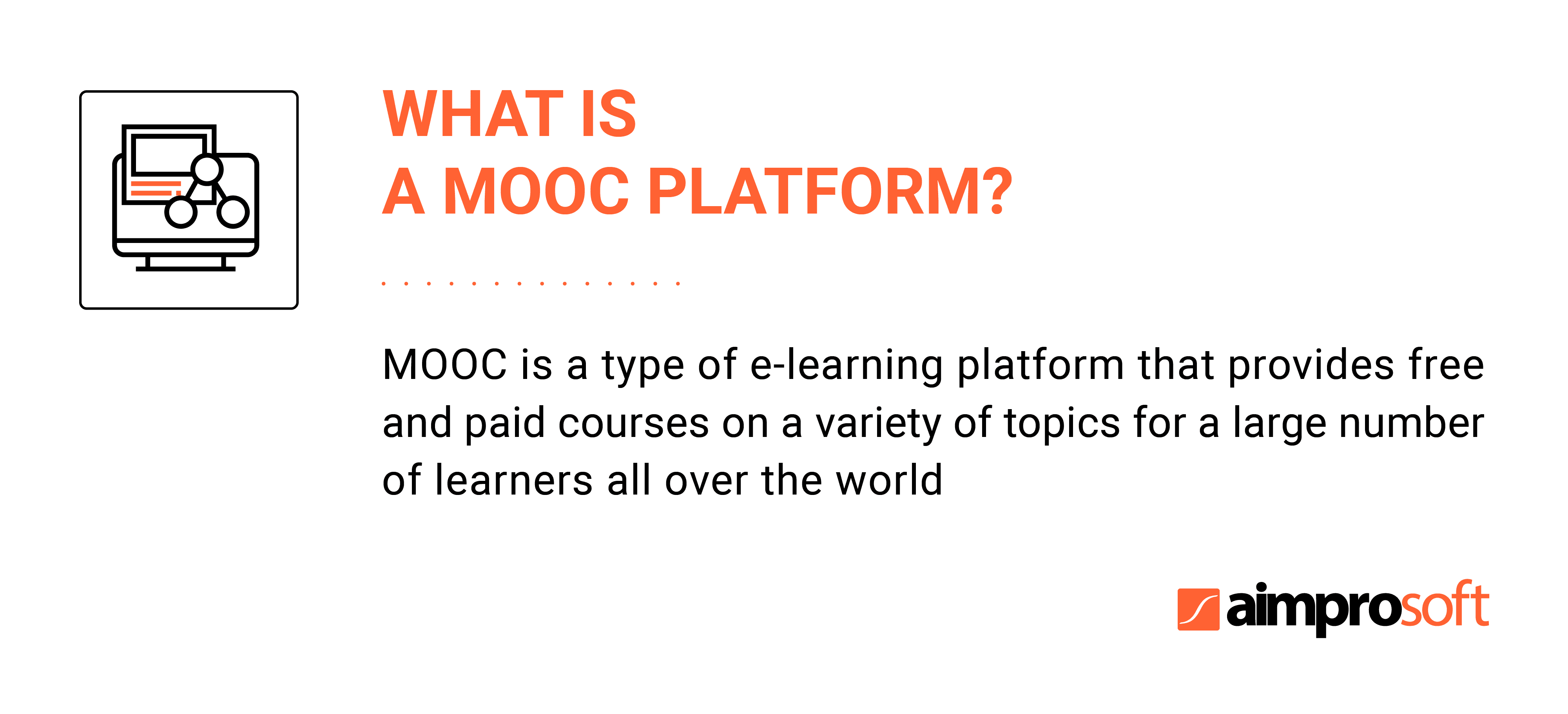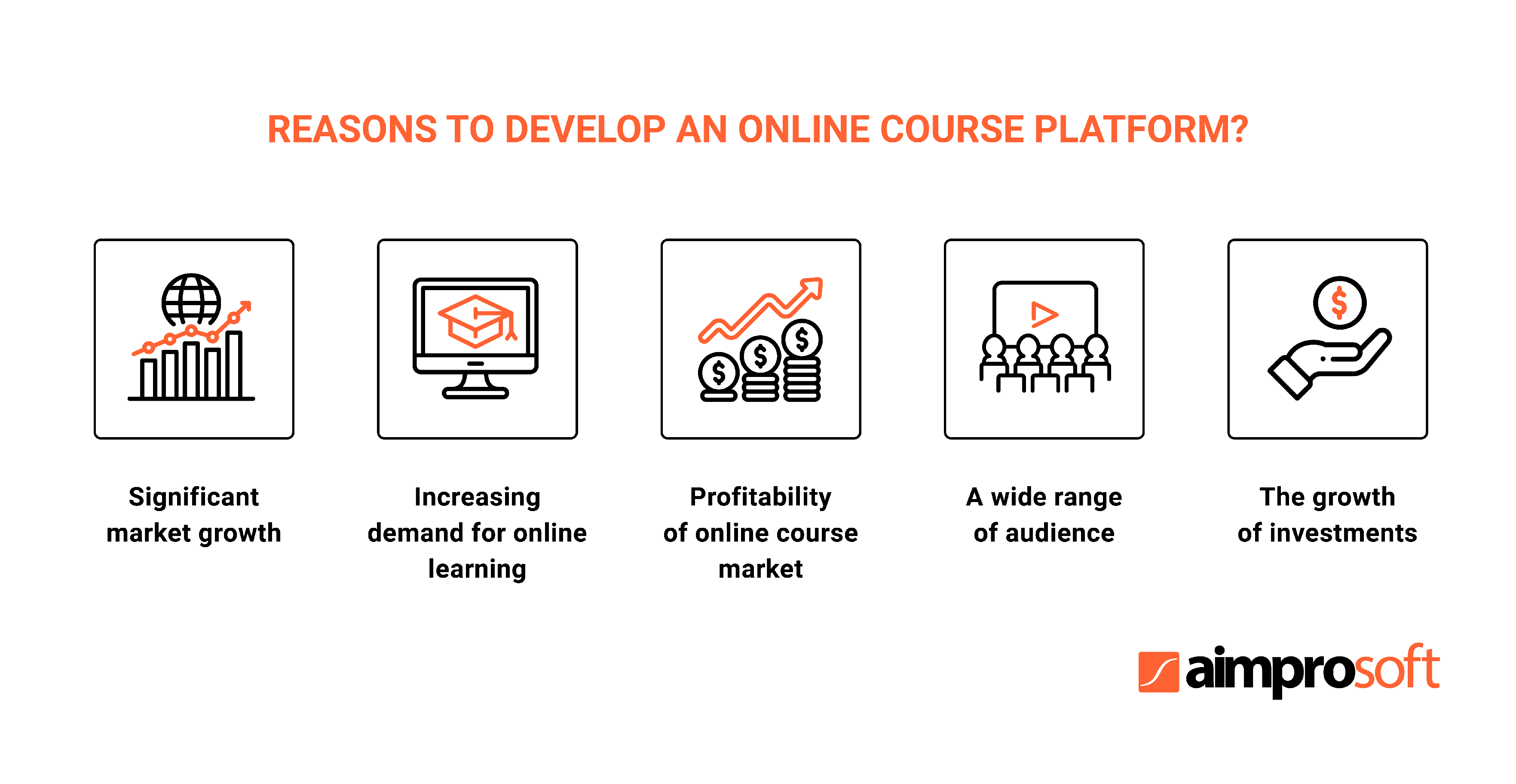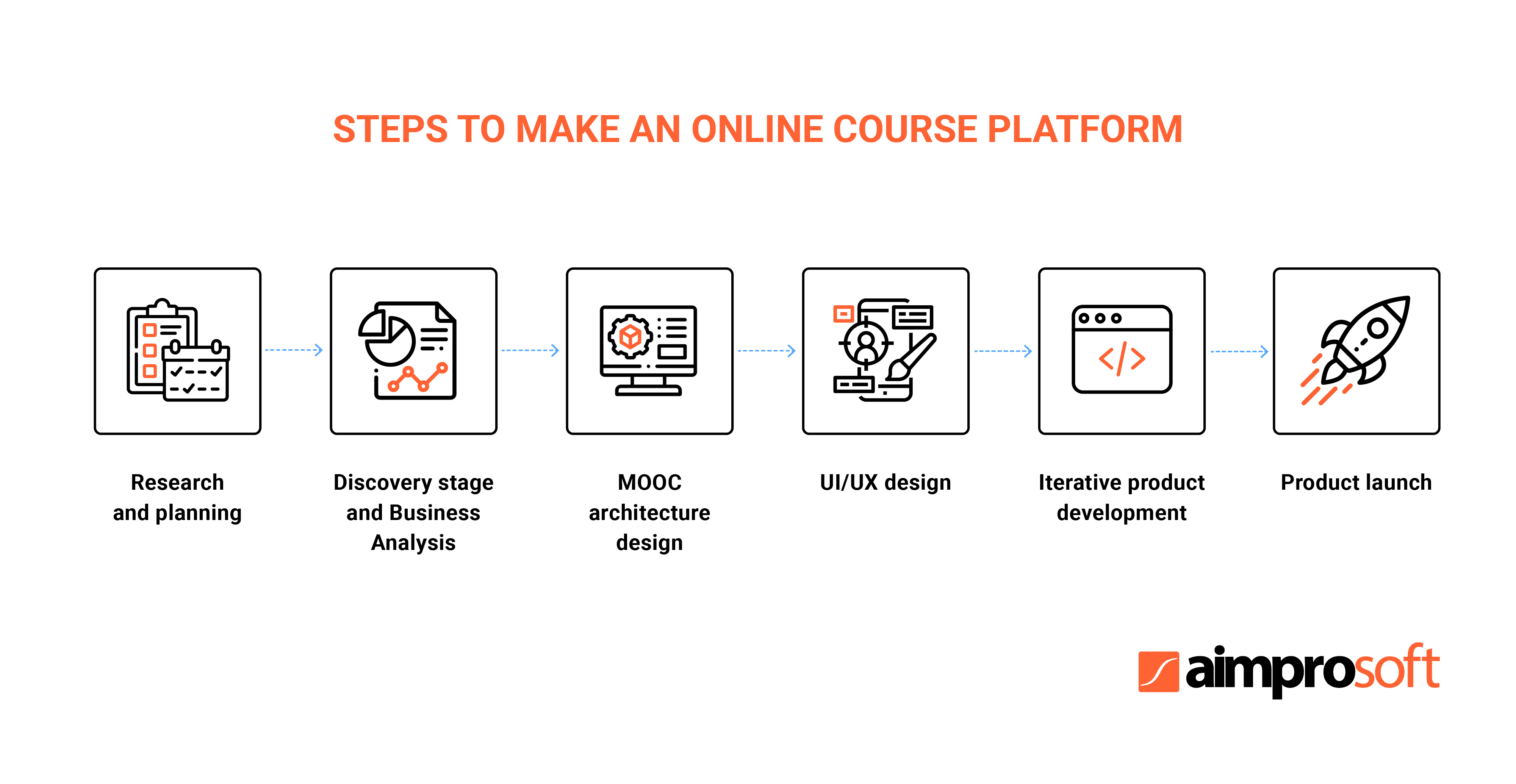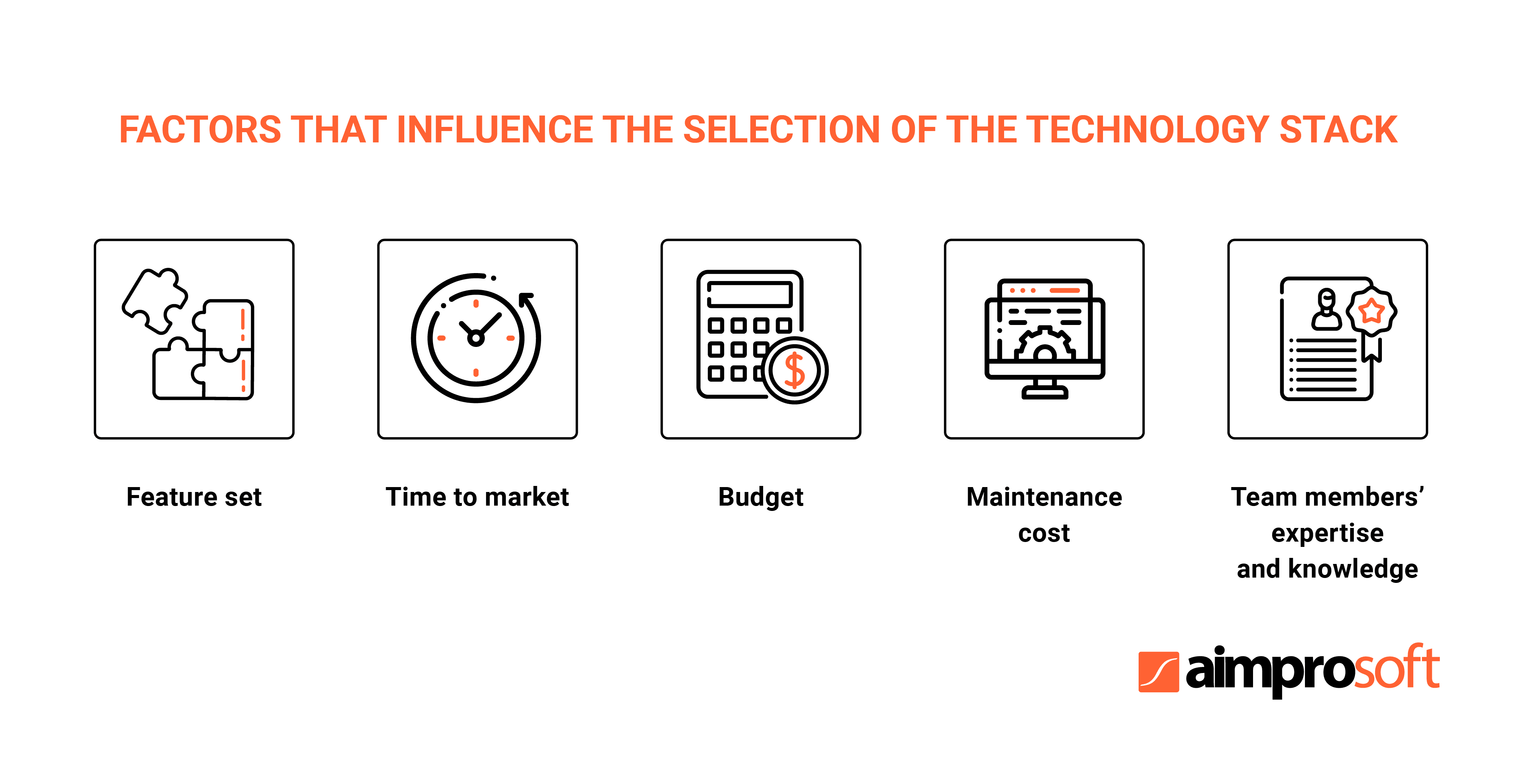How to Build a Website Like Udemy, Coursera, edX in 2024

Key takeaways
-
The online course market is projected to grow up to $25.33 billion by 2025. Find out key reasons why an educational platform is one of the most promising and lucrative solutions to develop.
-
Explore the comparison of top Massive Open Online Course (MOOC) platforms and the things they share that helped them succeed.
-
Discover core features that are a must when you aim to create an online course marketplace like Coursera or Udemy.
-
Check our comprehensive step-by-step guide to creating a massive open online course platform from scratch.
-
Aimprosoft approach to educational software development: learn how we implemented an MVP version of an online learning platform for our client.
The e-learning sector was struck with phenomenal growth over the past few years and especially during the pandemic. According to the statistics, the e-learning market is expected to grow up to $370 billion by 2026. Growth in users, developed educational solutions, and purchased courses leave no doubt that this segment is booming. In no time, the industry has become one of the most lucrative sectors to invest in. Thus, if not to develop a platform for online education now, then when?
Why should you create an online education website like Udemy or Coursera?

The essence of such an online educational platform is to provide learners with an affordable yet efficient alternative to costly and long-term traditional education. In turn, educators are given a chance to create courses and promote them. However, what are those reasons to create an e-learning website if the top giants in the segment of such solutions, such as Udemy, Coursera, and edX, have already established their firm position and conquered millions of learners?

Promising niche and its profitability
Nothing can prove the flourishing of the educational sector better than convincing statistics. Thus, according to the research conducted by PR Newswire, the e-learning market reached $226 Billion in 2020 and will continue growing at a CAGR of 8.56% during 2021-2026. Another study shows that the online course market is projected to reach approximately $25.33 billion by 2025, at a CAGR of 32.09% between 2019 and 2025. The numbers suggest that now is the best time to dispel all doubts and consider entering this niche with a promising start-up.
Growing demand for convenient online learning tools
Organizations, educational institutions, and separate individuals are eagerly shifting to a new format due to the ability to reach educational content at any time, from any location, and the opportunity to study at one’s own pace. Such eagerness of people to try new learning methods that only grow with the lapse of time is one of the reasons to jump on the hurtling train called digital transformation and create a robust solution that would meet their needs.
Audience range
One of the most significant reasons for developing an online education platform is the diversity of audiences that can be targeted. For instance, Udemy, Coursera, and Skillshare cover a wide range of users, including marketers, designers, writers, programmers, and many others. On the other hand, platforms like Udacity and Pluralsight provide courses mainly for tech specialists, IT administrators, and business professionals.
It means that none of these platforms cover the needs of every segment of users. Thus, you can develop a website like Udemy but for a narrow target audience of a particular age span and area of specialization, for instance, designers, photographers, or businesses who want to train their employees. It will eliminate the necessity to compete with market leaders and give you time to establish your business in a particular niche and grow it gradually.
The growth of investments
Finally, one of the reasons to consider starting a MOOC platform is a significant rise in funding all over the globe. For instance, the research shows that edtech start-up companies in the U.S. raised funding worth approximately $2.2 billion in 2020, which marked the highest investment rate in a single year for the e-learning industry.
Inspired by the phenomenal success of Udemy, Coursera, and other market leaders, investors are eagerly providing financial support to promising newcomers. Thus, it’s a great time to participate in one of the start-up accelerator programs and attract the attention of investors to your product. To learn more, check out our article about starting an edtech startup
Comparison of the e-learning platforms like Udemy, Coursera, edX, and others
If you plan to create a website like Udemy, it’s important to explore direct and indirect competitors, analyze their business models, and understand their strengths and weaknesses. Thus, let’s consider several top-notch platforms compared in the table below.
| Name | Who contributes | Type of courses | Number of users | Tech stack* | Business model |
|---|---|---|---|---|---|
| Udemy | Individual contributors | Any | 40+ million | Frontend: HTML5, CSS3, JavaScript, AngularJS, Bootstrap Backend: MySQL, Python, Django | – marketplace business model, it functions as a mediator and charges instructors a commission for every sold course (includes 3 revenue share tiers). – B2B model (includes different subscription plans for companies). |
| Coursera | Academic institutions, government, business companies | Any | 80+ million | Frontend: JavaScript, ReactJS, Bootstrap Backend: Scala, Python, Play, Django, Amazon S3, Amazon EC2 | – freemium business model ( there are free courses and students pay only for verified certificates); – purchase course model (students pay to access graded assignments); – B2B model (subscription fee to businesses and organizations). |
| edX | Academic institutions, research universities, non-governmental organizations, non-profit institutions | Any | 24+ million | Frontend: JavaScript, Backbone.js, Sass Backend: Python, Node.js, Django, MySQL, Elasticsearch, Amazon S3 | – freemium business model (students pay only for verified certificates); – partnership agreements – B2B model for business and organizations. |
| Linkedin Learning (former Lynda.com) | Professional instructors | Business, technology, marketing | 27+ million | Frontend: JavaScript, AngularJS, HTML5, CSS, Sass, Video.js, Backbone.js Backend: Java, Ruby, Elasticsearch, MySQL, MongoDB | – two pricing options (monthly and annual subscription); – team pricing plan (requires quote request) |
| Skillshare | Individual contributors | Creative arts, marketing, entrepreneurship | 12+ million | Frontend: JavaScript, React, VideoJS, Backbone.js, jQuery Backend: PHP, Nginx, Cloudflare | – freemium business model (students pay only for verified certificate) – premium membership; – B2B model for business and organizations. |
| *We have reviewed only the core technologies behind each platform. | |||||
The mentioned education websites are different in terms of categories of the provided courses, target audience, revenue model, and many other factors. However, these platforms share one important aspect, namely, things that helped them thrive:
- Flexibility. All analyzed platforms are all about self-paced learning that allows students to study conveniently at any time and place. They also easily run on different devices, which makes the learning process seamless.
Reasons to create an educational app for your MOOC platform.
-
User-friendly interface and easy-to-use functionality. Each platform from the table above provides comprehensible and simple UX, consistent, minimalistic, and visually appealing UI, which significantly facilitates their success.
-
High-quality courses. All courses offered by the platforms are created by professionals with a proven track record and credibility and by top-notch educational institutions. As a result, millions of users praised the mentioned platforms for the high quality of the provided learning materials.
-
Accredited certificates. The platforms provide learners with verified certificates for the successfully completed courses, which is the highest achievement for all the effort. Most of them are recognized by employers; the rest serve as proof of knowledge upgrade.
Having reviewed top market leaders, let’s review the most common features that all these platforms share that should be implemented if you want to start a website like Coursera and succeed.
Main features of the websites like Coursera and Udemy
Each e-learning platform differs in terms of functionality to a certain extent. However, there is a list of must-have features that ensure the learning process is convenient and efficient. If you want to know how to build a website like Udemy, Coursera, or edX, let’s explore them.| Feature | Notes |
|---|---|
| Dashboard |
When you aim to make a website like edX, it’s necessary to provide users with all the necessary tools for profile and course management (both for students and instructors), progress tracking, payment methods, and much more. |
| Advanced search and filtering |
Despite the number of existing courses on your platform, learners should be provided with advanced search, course filtering, rating system, and sorting that will allow them to maneuver among all courses without being baffled by uncategorized content. |
| Online courses |
Courses should be enriched with a diversity of tools that would make their creation, management, purchase, and usage seamless. Tools for teachers: course creation, updating, reviews displaying, files attachment, quiz creation, statistics. Tools for learners: Video player, course description, comment and review section, files downloading, lessons completion status, assignment attachment, knowledge check. |
| Notifications |
Make sure your solution has both email notifications and notifications within the platform. Moreover, don’t forget about notifications regarding discounts, new courses, events. etc., that shouldn’t be too frequent and intrusive. |
| Admin panel |
Admin should have all the necessary tools for user, content, notifications, and mailing management, report generation, and statistics viewing. |
| Gamification |
Gamification elements, such as achievements, points, rewards, etc., should be used not only to make the entire process more fun but also to engage users in the learning, remind them of the course they started, and stimulate their desire to complete it. |
| Customer support |
Make sure users can find the solution to the challenging situation easily. Your platform should include FAQ, helpdesk, chatbot, or live chat with customer support representatives, or any other problem-solving assistant. |
Now that we have examined the most vital features of e-learning platforms, let’s finally explore how to create a Udemy-like website.
Step-by-step guide on how to make a website like Udemy, Coursera
The creation of such a multifaceted product may be a thorny and winding path if certain vital stages are skipped. Let’s look at the right sequence of steps that should be completed to make the entire journey seamless and obtain a high-quality MOOC in the upshot.

Stage 0: Research and planning
If you want to know how to create an online education website like Udemy, explore the stage where everything starts. At this point, you don’t require the involvement of a software vendor; hence, it’s a pure pre-development stage where you will have to test the water before starting the project. The most important aspects to consider:
-
Research. This type of research is less thorough than the one conducted by business analysts and UX designers. However, it’s necessary to explore the niche that you are planning to enter with your e-learning platform, whether the courses will be solely for a narrow target audience or ones covering multiple areas. Having chosen a particular area in e-learning, it will be easier to analyze the target audience and their needs and your direct competitors in this segment.
-
Functionality. It’s important to determine at least the approximate functionality of your product so that you can deliver your idea to the chosen software development company more accurately.
-
Monetization strategy. It’s also vital to figure out the business model (e.g., subscription plans, freemium, donation-based, etc.) beforehand since it will not only define the way you will generate revenue but can also impact the functionality.
-
Contributors and content. The same applies to the sources of your learning materials, which should be defined before the actual development since it impacts design and functionality as well.
Stage 1: Discovery and Business Analysis
At this stage, the chosen educational software company comes into play. At Aimprosoft, we can assist you with e-learning platform development from the very first stage of its creation. In case you turn to our services with a mere idea, without requirements specification, wireframes, and previously conducted BA, we offer the following services at the discovery stage:
- discuss concept
- elicit requirements
- design project strategy
- create a basic visual design
- plan our further cooperation
Once the first arrangements are made, we advise conducting a business analysis. The potential contribution of BA to the success of the development process and project outcome is invaluable. By investing in this stage, you will be able to identify your market potential, obtain a detailed timeline of the project development and more clear technical requirements, avoid unforeseen expenses, and much more. By involving our business analysts in the project, you will obtain:
- thorough requirements specification
- detailed budget and time estimation
- defined project scope
- outlined business objectives
- written use cases
Contact us, and our BA will help you in this endeavor.
Reach usHaving reviewed the first stages of the e-learning platform development, let’s proceed with the design component and the most important aspects to consider in terms of this stage.
Stage 2: UI/UX Design
To ensure your e-learning platform can repeat the success of Udemy, edX, and other market leaders, it’s crucial to elaborate the design of the product thoroughly. There are certain guidelines that should be followed when you aim to build a website like Coursera so that users can have a seamless user experience and enjoy convenient learning processes.
| UI | UX |
|---|---|
| Minimalistic, clear, and concise UI (users shouldn’t be overwhelmed and distracted by a too vivid color palette and excessive imagery) | User-friendly navigation (absence of excessive tiers of navigation) |
| Consistency in terms of colors and visual elements throughout the entire platform | Simplicity (it’s necessary to avoid overwhelming users with functionality that is over the top within a particular structural block) |
| Readable typography | Structure (all content should be structured and categorized for a simplified perception) |
| Appealing layout | Clear information architecture |
| Clear and vivid call-to-action buttons | Inclusive design principles |
By creating a visually appealing design with high usability, you will be able to provide users with a convenient educational solution, increase retention rate, enhance overall user engagement, contribute to a positive brand reputation, and much more.
Stage 3: Technology Stack To Build a Website Like Udemy and Coursera
It would be too utopian to say that somewhere out there, there is a perfect technology stack that should be used to make a website like Coursera. Numerous factors influence the choice of software tools that will be used during product creation. Thus, before the start of any e-learning product development, at the discovery stage, our Software Architect assists with the selection of the best-fit technologies based on:

Technologies to implement the front-end constituent.
The front-end of an e-learning platform can be implemented by using either JavaScript or TypeScript programming language. In terms of the framework, we would advise opting for either Angular, React.js, or Vue.js.
Technologies to implement the back-end constituent.
If we consider the back-end constituent of such a product, there will be “slightly” more aspects to consider.
- Programming languages: Java, JavaScript, Python, .Net
- Frameworks & libraries: depends on the programming language
- Search engines: Elasticsearch, Solr
- Web/Application server: depends on the programming language
- Caching: Redis, Memcached
- Hosting: AWS, GCP, Microsoft Azure
- Databases: MySQL, MSSQL, PostgreSQL, MongoDB, Apache CouchDB
- Analytics and monitoring: Amazon CloudWatch, vRealize Log Insight, Grafana
- Source code storage: GitHub, AWS CodeCommit, GitLab
- Other tools: GitLab CI, TeamCity, GoCD, Jenkins, Terraform
Let our specialists assist with the selection of the most relevant technologies.
Contact usLMS constituent.
Apart from the tech stack, another vital thing to consider is the learning management system (LMS) that can be used as a solution to host a MOOC platform, create and manage courses. On the one hand, the usage of a ready-made open-source LMS, such as Moodle, TalentLMS, or Open edX, can significantly save cost and time in developing a significant part of MOOC functionality, especially when creating an MVP version. On the other hand, such solutions are not sufficiently flexible in terms of custom design and functionality implementation and may require the development of additional themes and plugins that may not be easily achievable.
To help you make the right choice, we assist with the selection of the most relevant development approach based on your business needs, the desired product launch, budget, and other factors.
Finally, throughout the entire product development cycle, it’s desirable not to skip iterative project management and QA to ensure you can have better progress visibility, mitigate possible risks, and stick to the set deadline and budget. To arm yourself with helpful LMS creation-related tips, we highly encourage you to check out our relevant articles about LMS nature, must-have features, and development approaches, and LMS step-by-step implementation.
How much does it cost to create an Udemy-Like website?
When you plan to build a website like edX, Udemy, or Coursera, it’s desirable to start with MVP first before going full-fledged in order to test your product’s feasibility, identify gaps, and obtain valuable feedback from users. Thus, let’s look at the list of the features that we suggest to implement when creating an MVP version of your platform:
- User registration & user authentication;
- Dashboard for instructors;
- Dashboard for users
- Course structure (summary, video player, instructor’s info, etc.);
- Course search;
- Course creation and management;
- Rating and reviews;
- Admin panel;
- Notifications;
- Payment gateway.
To design, implement, and test the above-mentioned functionality, you will need the following team stack:
- 1 Project Manager;
- 1 Business Analyst;
- 1 Software Architect;
- 1-2 UI/UX designer(s);
- 1-2 Backend developer(s);
- 1-2 Frontend developer(s);
- 1 QA engineer;
- 1 DevOps engineer.
Having considered must-have features for the MVP version of the MOOC platform and the team stack required to implement them, we offer to examine the time estimation to develop such a product from scratch.
| Stages | MVP ~ 1432 — 1985 hours |
|---|---|
| Discovery stage (Business Analysis + Technical specification) | 40 — 160 |
| Product architecture | 40 — 60 |
| UX research + UI with responsive version | 200 — 300 |
| Frontend + Backend development | 842 — 1060 |
| QA+testing | 210 — 265 |
| CI/CD | 100 — 140 |
Mind that the provided estimation is rather approximate and may vary if you decide to complete certain stages (e.g., BA, UI/UX design) with the provider of the corresponding services instead of opting for a full-cycle development. It also depends on the future set, product launch deadline, and many other factors.
Based on the estimated time required to build such a product, we have also calculated the approximate cost of MOOC platform development.
| Country | Average hourly rate | MVP ~ 1432 — 1985 hours |
|---|---|---|
| USA | $80 | $114 560 — 158 800 |
| Western Europe (Germany) | $65 | $93 080 — 129 025 |
| UK | $70 | $100 240 — 138 950 |
| Eastern Europe (Ukraine) | $35 | $50 120 — 69 475 |
As you can see, the cost to develop an e-learning platform like Coursera or Udemy significantly varies depending on the geographical area of the chosen software vendor. For instance, if you opt to implement the MVP version with a software development company from the USA, the cost may be rather high, approximately from $114 560 to $158 800. On the other hand, the cost to build a website like Coursera or Udemy will be two times less with a Ukrainian software vendor and will cost you a maximum of $69 475 for an MVP version.
If you are considering software outsourcing to Ukraine but lack irrefutable arguments to make up your mind, check our comprehensive overview of this topic.
Note that the price of the provided services doesn’t affect their quality, the time required to deliver the product, and the expertise of the vendor.
Our experience in building a website like Coursera and Udemy
When it comes to breathing life into the mere idea and transforming it into a robust product, we are always locked and loaded. Explore one of our educational projects to understand better the way we approach e-learning software development.
Case: MVP version of a MOOC platform for a promising startup
Background. The client turned to us with a mere concept. The idea was to develop an MVP version of a Coursera-like educational platform that would target learners interested in programming, data analytics, systems administration, cybersecurity, and other tech specializations, and individual contributors that would provide learning materials.
Requirements. The requirement was to implement convenient functionality for trainers so that they could create, manage, and sell their courses and provide learners with tools necessary for seamless educational processes.
Technology. Key technologies that were chosen for the product development: Node.js, React.js, Redux, Redux-saga, Elasticsearch, Redis, PostgreSQL, and multiple third-party tools for completion of operations related to payment, marketing, and analytics.
Solution. Before the functionality implementation stage, we conducted thorough market, TA, and competitor research, created detailed SRS (software requirements specification), and designed application architecture.
Once the pre-development stage was completed, we proceeded to the functionality implementation. The developed feature set was designed for three groups of users: learners, instructors, and admins. Our team created a robust dashboard where learners can track course enrollment and completion efficiently, manage their settings, receive notifications and reminders, and monitor events set by instructors. In turn, instructors obtained all the necessary tools to create their courses, tests, quizzes, and assignments, plan events, promote courses, and use an analytics dashboard that displays learner engagement, completed payments, course downloads, and views.
Admins are provided with the tools for convenient user, account, and billing management. Our team also implemented functionality for marketing-related operations (i.e., lead generation tool, funnels, email campaigns, and others) with the help of integration of third-party tools. Finally, the developers implemented a payment gateway by integrating the platform with Stripe and PayPal payment options.
Outcome. As a result, we created a feature-rich solution ensuring the needs and pains of the potential users are considered. With the developed product, our client managed to validate the idea and lay the groundwork for a full-fledged version of the existing MOOC.
Apart from e-learning platforms, we are skilled in the development of many other educational solutions. To learn more about our expertise, check Aimprosoft’s guide to making a language learning app successfully.
Conclusion
The contribution to the digitization of the educational sector is not only a noble act, it’s also an extremely thought-out, promising, and profitable one. The market for e-learning solutions is growing by leaps and bounds, attracting the attention of learners, entrepreneurs, organizations, and sponsors. Thus, if you have a great design to create a website like Сoursera or Udemy and need assistance from an experienced software vendor, contact us to discuss your project.
FAQ
Can I start with a full-fledged MOOC skipping the MVP version?
MVP is a rather powerful tool, yet it’s often underestimated. We highly recommend not skipping the creation of the MVP version of the product since it allows you to test the market, target audience, and chosen business model in a cost-efficient way, enables you to launch the solution faster, and helps identify the weaknesses in core functionality before investing in a full-fledged product with costly extensive functionality.
What are the possible challenges when creating such a platform?
Non-technical challenges may include validation and plagiarism checks of the uploaded learning materials and courses and the selection of contributors and partnership models. On the other hand, technical challenges may be related to ensuring high-speed loading, creating a robust course constructor, enabling proper security of user-sensitive data, and proper adherence to the industry regulations, including PCI DSS, GDPR, AICC, and others.
Is it necessary to have a mobile e-learning app for my MOOC platform?
The possibility to expand the user base, implement a new business model and omnichannel strategy, offer users new functionality, and increase revenue makes the growing number of businesses related to e-learning go mobile. If you want to create a website like Coursera or Udemy, it’s important to develop a robust web-based solution first and acquire a loyal customer base. However, eventually, it’s highly desirable to build a supplementary mobile app to provide your users with a convenient tool to access learning materials at their fingertips.




